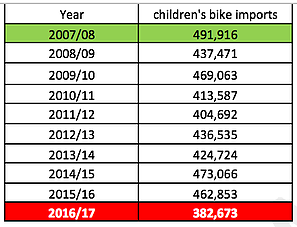Decade decline in children’s bike sales points to crisis in physical activity
28 August 2017 | Government relations

Sales of children’s bicycles have hit a new low leading to concerns that Australian children are not active enough to ensure their long term health and well-being.
Sales of children’s bicycles reported by the industry[i] fell 22% in the decade to 2017, from 492,000 in 2007-8 to 382,000. These are the lowest figures since 2003-04 when 431,000 children’s bicycles were sold.
The Australian Cycling Promotion Foundation[ii] (ACPF) is concerned that it has become too hard for children to be active as part of their daily trips to school and other local destinations.
“The ACPF believes that the declining sales are a simple indicator that we need to do more to make walking and cycling a real option every day for our children,” ACPF spokesperson Stephen Hodge said.
“Seventy-one per cent of children and 92% of young people do not meet the recommended guidelines for physical activity in Australia[iii].
“In areas where safe routes to school exist, kids are happily commuting by foot, scooter and bike with the full support of parents and teachers.
“We call on governments at all levels to focus on safe routes to school for our children as a first step to building a healthier, more engaged and more successful future generation,” Mr Hodge said.
The ACPF is meeting today with many of Australia’s foremost health experts at a roundtable event hosted by the Australian Health Policy Collaboration (AHPC) and Heart Foundation to discuss a national approach to active travel for school children.
“A coordinated approach to active travel to and from school will give 3.7million children in schools access to healthy physical activity every day and embed good health promoting behaviours from an early age,” Rosemary Calder, Director, AHPC.
According to the CEO National of the Heart Foundation, Adjunct Professor John Kelly, a survey of parents found that only 7% said their children did the recommended one hour per day of exercise, which means an estimated 600,000 children are inactive (Australian Bureau of Statistics 2013 Health Survey).
“It is vital we encourage daily physical activity for all our children and the daily trip to school is one of the best value investments we can make for their future health,” Professor Kelly said.
Key information:
-
Children cycle more when they have access to safe routes to school, recent data from the City of Sydney shows 40% of 10 to 17 year olds in the City area are riding bikes, double the greater Sydney figure, http://www.sydneymedia.com.au/bike-riding-twice-as-popular-in-inner-sydney/
-
A national survey by the ACPF and Heart Foundation found that 60% of parents drive their children to school, just over a quarter walk to school, one in five use public transport and just over one in ten ride a bike[iv], also
-
Whilst seven in ten parents surveyed think it is important for children to be able to independently ride a bike, close to half do not believe that it is safe for children to ride a bike to school.
-
Eight in ten parents surveyed agreed that there is too much traffic on the roads and there are not enough bike paths for children to cycle safely to school.
-
-
Data from the US shows that an increase in separated cycling infrastructure results in higher rates of cycling and lower injuries, see AJPH December 2016, Vol 106, No. 12, Table 1, accessed 22 Aug 2017: http://ajph.aphapublications.org/doi/pdf/10.2105/AJPH.2016.303507
– Bicycle sales statistics are published each year by Bicycle Industries Australia
-
The Australian Cycling Promotion Foundation (previously the Cycling Promotion Fund) builds on nearly 20 years of national advocacy to empower decision makers and inspire all Australians to choose cycling. As an independent voice in Australia, we are working to:
-
Secure the infrastructure and programs to ensure cycling contributes to healthy, safe and enjoyable mobility for all
-
Build the case for investment in infrastructure
-
Disseminate evidence and data to support the role of cycling in community and national agendas,
-
Present the positive, healthy and safe reality of daily cycling across the country by children, adults and seniors from all walks of life. See www.cyclingpromotion.org for more info.
-
-
The Australian Health Policy Collaboration, promotes and supports a national policy agenda for the prevention of chronic diseases that improves population health and wellbeing in Australia (https://www.vu.edu.au/australian-health-policy-collaboration)
Media contacts for comment and interviews:
Australian Cycling Promotion Foundation – Stephen Hodge, mob. 0411 149 910, shodge@cyclingpromotion.com.au; Peter Bourke mob. 0438 871 271, pbourke@cyclingpromotion.com.au.
[i] The annual bicycle sales statistics are collated by Bicycle Industries Australia, for full details visit www.bikeoz.org
[ii] The Australian Cycling Promotion Foundation was launched on 1st July 2017 as an independent not-for-profit foundation, building on nearly twenty years of national bicycle advocacy by the Cycling Promotion Fund. For more information visit www.cyclingpromotion.org.
[iii] Getting Australia’s Health on Track, Australian Health Policy Collaboration, accessed 14 Aug. 17; https://www.vu.edu.au/sites/default/files/getting-australias-health-on-track-ahpc-nov2016_0.pdf
[iv] Active Travel to School, Cycling Promotion Fund and Heart Foundation, 2012, accessed 23 Aug 2017, https://docs.wixstatic.com/ugd/27b1f8_2deddde666504304801fce519033cd12.pdf
